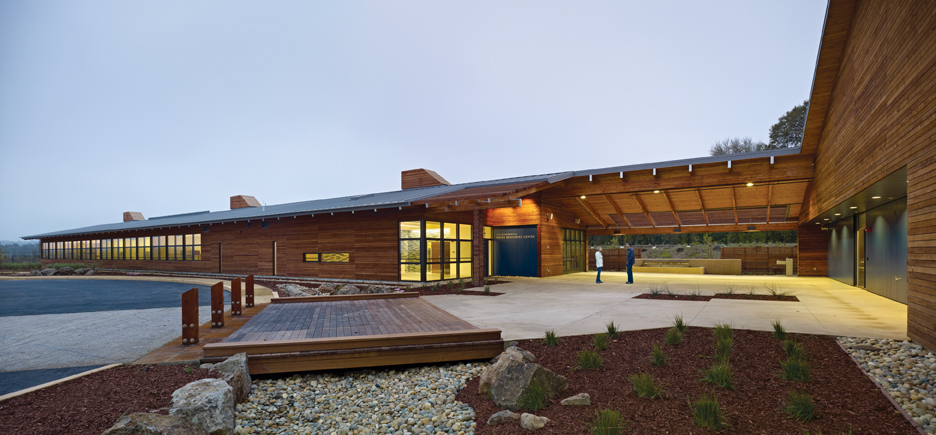In California’s Pajaro Valley, 85% of water use goes toward supporting the local $400 million agricultural industry. The new Water Resources Center reflects the community’s resource conservation and recycling efforts.
The City of Watsonville (Calif.) Water Resources Center consolidates three city and county water departments under one roof and serves as a support facility for the Watsonville Area Water Recycling Project, a program that provides recycled water to farmers in the Pajaro Valley, which includes the coastal areas of South Santa Cruz and North Monterey counties. As much as 85% of the valley’s water use directly supports its $400 million agriculture industry, and the recycling effort provides 4,000 acre-feet of recycled water per year.
The city wanted a simple, highly sustainable building to support its mission. Compromises were made in certain areas that were deemed luxuries—carpeting, perfect acoustics, ideal indoor temperatures—but not on water or energy conservation or material efficiencies.
The project is seeking LEED Platinum certification. “They are living their mission and their purpose,” said Building Team Awards judge Terry Fielden, LEED AP, Senior Project Executive in Gilbane Building Company’s Chicago office.
The $11 million facility from the Building Team of WRNS Studio (architect), Devcon Construction (contractor), Integrated Design Associates (electrical engineer), and Rumsey Engineers (now Integral Group [mechanical/plumbing engineers]) was designed to optimize resources. A plywood roof diaphragm is supported by exposed tongue-and-groove decking over rolled Douglas fir glulam beams. The wall structure uses wood studs at 24 inches on center, which reduced the wall structure by 30%; overall construction materials were reduced by 50% compared to a conventional structure.
The facility’s rainscreen is made from redwood trees on the property that were harvested as part of a fire prevention effort and milled eight miles away. The wood was finished with a low-VOC sealer that will allow it to weather and patina naturally, making it an ideal cladding material for the salty coastal air.
To restore the land to pre-agricultural conditions, bioswales and infiltration swales were incorporated into the landscape, which was planted with native and drought-tolerate plants that are only watered when recycled water is available. When it rains, water is directed away from the building and paved areas into retention basins and treated before infiltrating the ground.
The 16,000-sf facility treads lightly on its site, measuring 43 feet by 290 feet. It is oriented on an east-west axis to maximize daylighting and take advantage of the prevailing cool ocean winds. Operable windows, skylights, and window wall systems open the building to the outside and filter daylighting throughout the open-concept interior; adjustable and mobile furniture and fixtures increase usable floor area by 35%. Deep eaves help control solar heat gain.
Rooftop vents work in conjunction with open windows to let the sea breezes naturally ventilate the building. In the facility’s high-performance lab, active and passive HVAC systems allow researchers to regulate their environment without compromising lab efforts. By decoupling the system, engineers were able to gain additional efficiencies. The center’s main source of heating and cooling, however, comes from radiant tubes filled with reclaimed water and imbedded within the exposed polished concrete floor. The center’s low-flow plumbing fixtures and dual-flush toilets helped reduce its potable water consumption by 50% and exceed ASHRAE 90.1 by 76%.
Since opening in March 2010, the building has become a popular community attraction, in particular as an interpretive center where visitors can learn about the region’s complex water issues.
A Simple Building Addresses Complex Water Needs
Gold Award: City of Watsonville Water Resources Center







